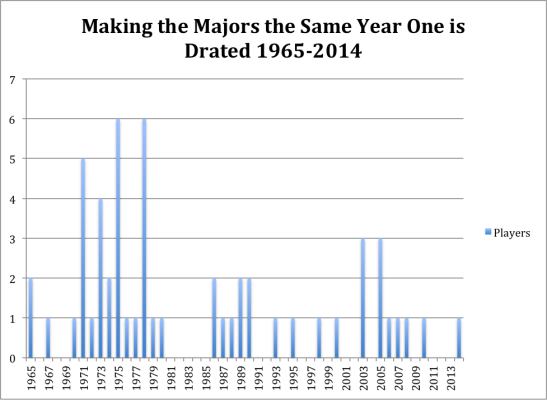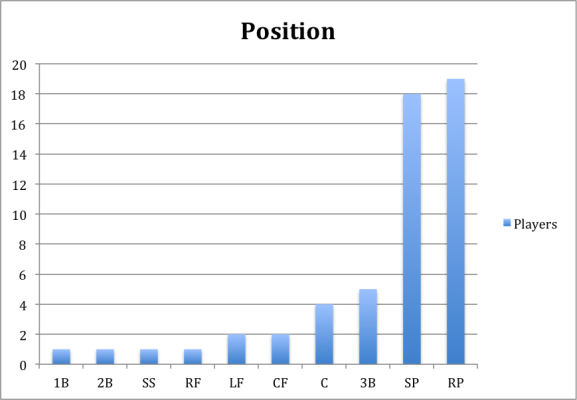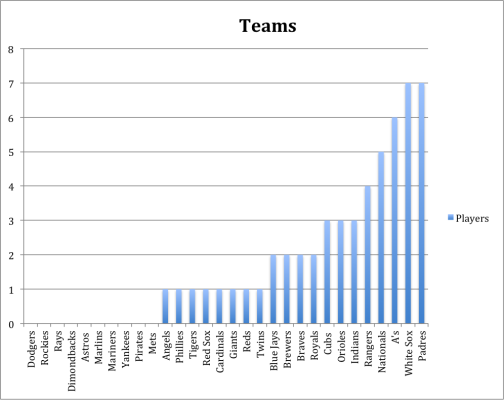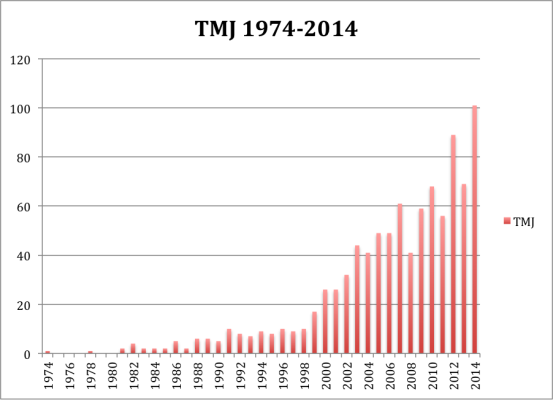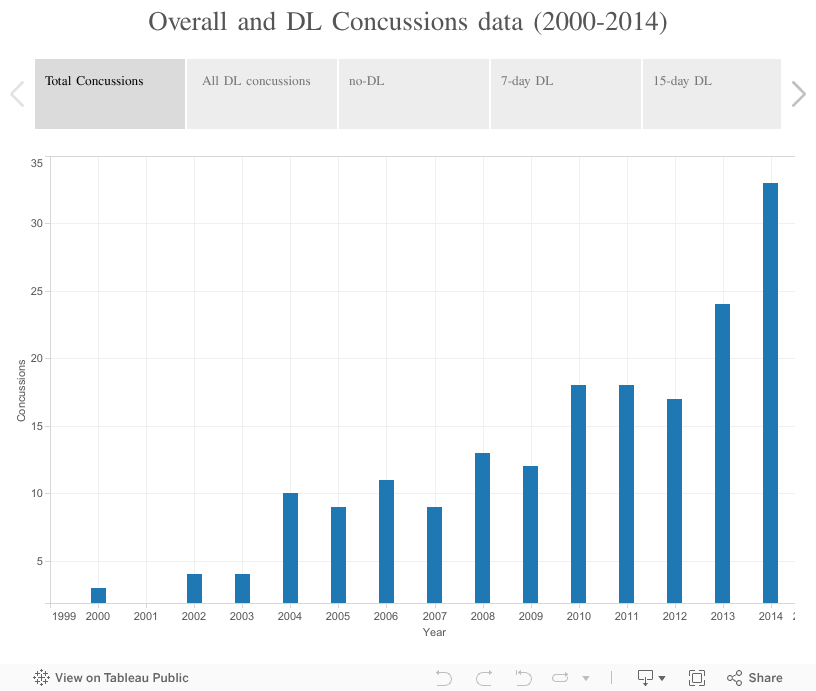Effect of Stats So Far on Depth Charts RoS Projections
Major League Baseball teams have played more than one-fourth of their schedule so for and there is new data to incorporate into projections. Some players are off to amazing starts (Bryce Harper and Nelson Cruz), while others have really struggled (Troy Tulowitzki and Steve Pearce). With that in mind, I thought I’d look at which players have seen their rest-of-season projections change the most from their preseason projections. I used the preseason Depth Charts projections and compared each player’s preseason projection for AVG/OBP/SLG and wOBA to their rest-of-season Depth Charts projection. All statistics are from May 25th.
The Biggest Losers
SS Troy Tulowitzki (-.019)
.272/.288/.415, .301 wOBA—current
.307/.386/.539, .400 wOBA—preseason
.300/.370/.515, .381 wOBA—rest-of-season
The statistic that stands out most when looking at Tulowitzki is an extremely low walk rate of just 2.6%. Tulo’s career walk rate is 9.8% and the lowest single-season walk rate he’s had was an 8.4% mark in 2007, his second year in the major leagues. He also has a strikeout rate (21.7%) that is 5.7% higher than his career mark. According to Pitch f/x Plate Discipline, Tulowitzki is swinging at more pitches outside the strike zone (on pace for a career high of 32.9% O-Swing%) and more pitches inside the strike zone (65.6%, career mark is 57.8%) and making less contact than he ever has in a season (78.2% Contact%). When it comes to balls in play, Tulowitzki has seen just 4.3% of his fly balls leave the yard, far below his career rate of 15.1% HR/FB. Despite his struggles, his rest-of-season projection of a .381 wOBA is still elite for a shortstop even if it’s dropped .019 from his pre-season projection of .400.
2B/OF/1B Steve Pearce (-.018)
.188/.262/.323, .259 wOBA—current
.266/.346/.471, .358 wOBA—preseason
.254/.333/.446, .340 wOBA—rest-of-season
Pearce is striking out slightly more than he did last year (20.6% to 19.8%) and walking a bit less (7.5% to 10.4%), but nothing as glaringly different from the norm as Troy Tulowitzki has shown so far (see above). One of the biggest problems for Pearce has been a .197 BABIP, down from .322 last year and well below his .287 career mark. His BABIP is down despite a career-best 25.3% line drive rate. His HR/FB is also close enough to last year’s rate to not be anything to worry about (14.3% this year, 17.5% last year). According to Pitch f/x Pitch Types, Pearce has seen a much lower percentage of two-seam fastballs (4.5%) than he did last year (14.1%) even though his overall percentage of fastballs is up (45.1% to 43.7%), so pitchers are attacking him a bit differently. The heat maps below show the swing percentage for Steve Pearce in 2014 on the left and his swing percentage for 2015 on the right. It looks like pitchers are getting Pearce to swing at more pitches in the upper half and inside part of the strike zone with four seam fastballs. Can he adjust?

OF Carlos Gonzalez (-.017)
.206/.285/.326, .275 wOBA—current
.281/.346/.509, .370 wOBA—preseason
.270/.338/.481, .353 wOBA—rest-of-season
Unlike his equally disappointing teammate, Troy Tulowitzki, Carlos Gonzalez is walking more and striking out less than he has in the last couple seasons. His walk rate of 10.1% is higher than his career mark of 8.0% and his strikeout rate of 20.8% is below his career mark of 22.3%. Like Steve Pearce, CarGo has a BABIP problem. From 2008 to 2013, Gonzalez never had a BABIP below .318 and his career mark over 2826 plate appearances was .350. Last year, he had a .283 BABIP. This year, it’s down to .238. His batted ball profile shows a 22.9% line drive rate, which is higher than his career rate of 20.2%. He’s hitting more ground balls and fewer fly balls than he has historically, which should help his BABIP. When looking at Gonzalez’ hard hit percentage, we find his 27.3% mark this year is his lowest since his rookie year. In his two best season’s (2010 and 2013), CarGo had his two best Hard Hit percentages, at 43.8% and 38.8%. With Gonzalez and his history of injuries, you never know if he’s truly healthy. His plate discipline numbers suggest he’s fine in that regard but that low hard hit percentage is troublesome.
OF Melky Cabrera (-.014)
.241/.287/.271, .253 wOBA—current
.292/.342/.436, .342 wOBA—preseason
.286/.335/.414, .328 wOBA—rest-of-season
Melky is suffering from a low BABIP of .252 (career mark is .308) but his batted ball profile isn’t much different from last year as far as line drives, ground balls, and fly balls are concerned. His HR/FB is way down at 2.4% (last year it was 10.7%) and his Hard% of 19.6% is well below his 2014 rate of 30.5%. He’s walking about as much as he usually walks and is striking out less often than he ever has so he’s making contact, it just hasn’t been good contact.
2B Robinson Cano (-.013)
.253/.295/.337, .279 wOBA—current
.296/.361/.455, .353 wOBA—preseason
.289/.351/.438, .340 wOBA—rest-of-season
Through more than one-fourth of the season, Robinson Cano has just one home run. Other than a terrible 2.9% HR/FB, his batted ball profile looks much like last year and his Hard% of 32.6% is better than last season’s 28.5% mark. As for plate discipline, his walk rate is down to 5.4% after averaging over 9% in the three previous seasons. He also currently has the highest strikeout rate of any season of his career, at 16.7%, with a contact percentage down by approximately 5% on pitches both inside and outside of the strike zone.
The Biggest Winners
OF Bryce Harper (+.019)
.333/.471/.727, .494 wOBA—current
.279/.363/.491, .372 wOBA—preseason
.287/.383/.528 .391 wOBA—rest-of-season
Bryce Harper’s monster start to the season has raised his wOBA projection by .019, the largest increase for any player. This looks like the year Harper has made the jump to elite level. His walk rate of 20.9% is well above his career rate of 11.6%. He’s been hitting so well, and with such power, that pitchers just don’t want to throw him anything to hit. His percentage of strikes out of all pitches thrown was 61.7% in his first three years in the major leagues. This year, pitchers are throwing strikes to Harper just 55.8% of the time. He’s also swinging less often on pitches both inside and outside the strike zone and has a career-best 40.0 Hard% when he does make contact. His HR/FB of 35.6% is almost double his career rate and he’s increased the percentage of fly balls he’s hit and the percentage of balls he’s pulled. It looks like he’s matured into the player everyone thought he’d be.
C Stephen Vogt (+.019)
.307/.410/.598, .424 wOBA—current
.255/.303/.398, .308 wOBA—preseason
.263/.322/.429, .327 wOBA—rest-of-season
Stephen Vogt has some of the same indicators as Bryce Harper. Vogt is also seeing fewer strikes (58.2% after seeing 64.1% strikes in his first three seasons) and has a career-best walk rate of 15.1% (career rate is 8.1%). His HR/FB rate of 22.2% is more than double his career rate (10.6%) and he’s pulling more balls than he ever has.
OF Nelson Cruz (+.016)
.341/.398/.688, .458 wOBA—current
.250/.309/.457, .334 wOBA—preseason
.262/.322/.492, .350 wOBA—rest-of-season
Unlike Harper and Vogt, Cruz has a walk rate that is very close to his career mark. He’s also striking out just a little more than he has during his career, so he’s not walking or striking out at a much different rate than he normally does. He does have a very high .374 BABIP (career BABIP is .302) and the best HR/FB rate of his career, at 31.5% (career mark is 17.9%). With Cruz being on the positive side of the biggest changes in projected wOBA from the preseason to now and his teammate Robinson Cano being on the negative side, the only explanation is that Cruz stole Cano’s mojo.
The interesting thing is that the Cruz and Cano combined are not far off from preseason projections when pro-rated to their current 376 combined plate appearances:
376 PA, 44 R, 14 HR, 49 RBI, .274/.336/.456—Combined preseason projection for Cano & Cruz pro-rated to their current 376 plate appearances.
376 PA, 48 R, 18 HR, 48 RBI, .296/.346/.508—Current combined hitting statistics for Cano & Cruz.
DH Alex Rodriguez (+.015)
.262/.363/.545, .388 wOBA—current
.231/.311/.386, .310 wOBA—preseason
.236/.323/.417, .325 wOBA—rest-of-season
Heading into his age 39 season and having missed all of 2014, expectations were low for Alex Rodriguez this year. And yet, here he is with a very good .263/.363/.545 batting line and 10 home runs in 41 games. His current .388 wOBA would be his highest since 2009. Of course, the projections don’t see that happening but they have bumped up his wOBA from .310 before the season started to .325 for the rest of the season. A-Rod is walking and striking out at similar rates to his 2013 season and has a similar BABIP to that year as well, but he’s increased his HR/FB percentage from 15.6% in 2013 to 23.3% so far this year. That rate would be his best since 2007.
1B Mark Teixeira (+.015)
.236/.362/.563, .387 wOBA—current
.229/.319/.422, .327 wOBA—preseason
.234/.332/.454, .342 wOBA—rest-of-season
Mark Teixeira has seen a projected increase of .015 in his wOBA from the preseason to the rest-of-season thanks to a .387 wOBA through his first 43 games. Teixeira is doing this despite a .191 BABIP, which is well below his career mark of .285. Of course, Teixeira routinely had BABIPs above .300 in the first seven years of his career but has been below .250 in each of the last five years. He is walking more than he ever has (15.6% BB%) and striking out at a career-low rate (12.1%). He also has a 25.5% HR/FB, which would be a career high.
